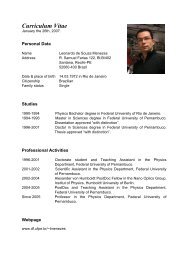Download Abstracts Book - DF-UFPE Pessoal
Download Abstracts Book - DF-UFPE Pessoal
Download Abstracts Book - DF-UFPE Pessoal
You also want an ePaper? Increase the reach of your titles
YUMPU automatically turns print PDFs into web optimized ePapers that Google loves.
ORAL CONTRIBUTIONS<br />
Madelung Energy of Regular Lattices<br />
P. C. N. Pereira and S. W. S. Apolinario<br />
Departamento de Fisica, Universidade Federal de Pernambuco, 50670-901 Recife, PE, Brazil<br />
Due to strong Coulomb repulsion, an electron gas at low temperature and<br />
density undergoes a phase transition to a crystalline state called the Wigner crystal, as<br />
predicted theoretically by Eugene Wigner in 1934. The Wigner crystal is one of the<br />
possible ground states of a strongly correlated electron system. Wigner crystallization<br />
was first observed in an electron gas confined above the surface of liquid helium by<br />
Grimes and Adams. Several theoretical and experimental works have considered the<br />
properties of a finite number of particles interacting through a repulsive interparticle<br />
interaction potential and kept together by an external confinement potential. Typical<br />
experimental realizations of such 2D systems include electrons on the surface of liquid<br />
helium, vortices in a type II superconducting 2D films, colloidal suspensions, and dusty<br />
plasma crystals. These systems and their configurations have been observed<br />
experimentally, and depending of their conditions, they can form regular lattices.<br />
We propose a method to compute the Madelung energy (ME) of regular lattices.<br />
As a first test, such a method was applied for Yukawa lattices [1] of different topologies<br />
and dimensions which resulted in an approximate closed form expression of the ME.<br />
The obtained Madelung energies have a satisfactory accuracy for all ranges of the<br />
screening parameter κ of the Yukawa potential, and it becomes exact in the asymptotic<br />
limits κ→0 and κ→+∞. For instance, for the triangular lattice, the maximum relative<br />
error of the ME given by the method is about 0.0047. Also, satisfactory results are<br />
obtained for the one-component plasma limit. The Madelung constants of the twodimensional<br />
hexagonal BN and square NaCl and the three-dimensional cubic NaCl<br />
crystals are estimated with a relative error of 0.004, 0.006, and 0.03, respectively.<br />
Finally, different ways to improve the method are presented and discussed.<br />
[1] Medelung energy of Yukawa lattices, P. C. N. Pereira and S. W. S. Apolinario,<br />
Phys. Rev. E 86, 046702 (2012).<br />
29






